#plesiosuchus
Explore tagged Tumblr posts
Text
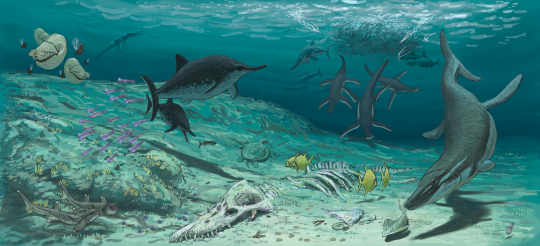
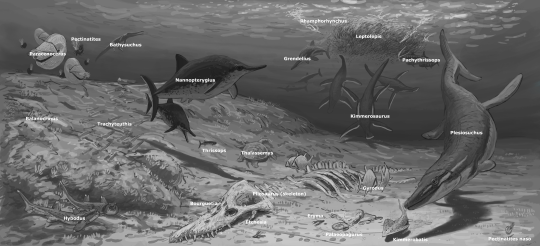
Result from the Kimmeridge Clay #paleostream!
We were only able to scratch the surface, but I think you get the idea ;)
#sciart#paleoart#paleostream#palaeoblr#jurassic#kimmeridge clay#pliosaurus#plesiosaur#plesiosuchus#nannopterygius#kimmerosaurus#sea#britain
598 notes
·
View notes
Text
Archovember 2024 Day 14 - Cuspicephalus scarfi

Cuspicephalus scarfi was a wukongopterid pterosaur from Late Jurassic England. It’s name comes from the Latin cuspis for “point” and the Greek κεφαλή for “head”, and its species name is a reference to Gerald Scarfe who was known for caricatures with very pointy noses (including Margaret Thatcher as the “Torydactyl), and who was also the production designer for Disney’s Hercules. Cuspicephalus scarfi basically means “pointed head which could have been designed by Gerald Scarfe.” Looking at this animal you can probably see the resemblance! Cuspicephalus had a very long, angled skull, most of which was occupied by the air pockets in its fenestra. A low bony crest is present, which was likely the base of a much higher soft tissue crest. Like most other Jurassic pterosaurs, it had sharp interlocking teeth, and likely also had a long ornamented tail. Due to its small size and lightly built skull, it probably fed on small land animals like arthropods and worms.

Cuspicephalus scarfi was found in the Kimmeridge Clay Formation. This was a seaside environment and is known for its many fish, turtle, plesiosaur, and icthyosaur fossils. Other pterosaurs have been found here as well, but from later ages than Cuspicephalus. Other archosaurs would have included the stegosaur Dacentrurus, the iguanodontian Cumnoria, the megalosaurid Torvosaurus, and the thalattosuchians Bathysuchus, Cricosaurus, Dakosaurus, Metriorhynchus, Plesiosuchus, and Torvoneustes.

This art may be used for educational purposes, with credit, but please contact me first for permission before using my art. I would like to know where and how it is being used. If you don’t have something to add that was not already addressed in this caption, please do not repost this art. Thank you!
#sorry it’s late I did post this this morning but Tumblr glitched and then it disappeared and wouldn’t let me repost it#had to log out and back in once I had better internet but now we’re here#Cuspicephalus scarfi#Cuspicephalus#Wukongopterid#pterosaurs#archosaurs#archosauromorphs#reptiles#Archovember#Archovember2024#Dinovember#Dinovember2024#SaritaDrawsPalaeo#Late Jurassic#England#Kimmeridge Clay Formation
37 notes
·
View notes
Text
Just like the last time, all animals will behave as they would in nature (or as close to for all extinct species) the only difference is that your defender(s) will avoid causing friendly fire. However, any attempt to harm and/or eat your defender(s) will cause them to turn on you.
Also thought it wise to specify specific options to avoid confusion and people trying to bend the rules. (Sorry if I’m sounding like a party-pooper)
#poll#wet beast wednesday#invertibrates#cephalopods#crabs#cnidarians#siphonophore#fish#sharks#cetaceans#dolphin#extinct animals#plesiosaur#crocodylomorpha#thalattosuchians#mosasaurid#marine animals#marine life#marine biology
193 notes
·
View notes
Text
Hace 138 millones de años, en lo que hoy es Europa, un depredador acecha entre las olas de un mar poco profundo.

Su silueta es imponente, cortando el agua con el sigilo de un asesino experto. No es un reptil cualquiera. Es un Plesiosuchus, un coloso marino de más de seis metros, pariente de los cocodrilos, pero con un cuerpo diseñado para la velocidad y la caza en alta mar.
Su presa, un plesiosaurio, nada desprevenido, sus aletas impulsándolo con elegancia. No hay tiempo para reaccionar cuando las mandíbulas del depredador se cierran con una fuerza devastadora. Los dientes, afilados como cuchillas, desgarran la carne. El agua se tiñe de rojo.
A la distancia, otra sombra observa el ataque. Se trata de un Torvoneustes, un metriorrínquido de menor tamaño pero igualmente letal. Especializado en devorar peces y ammonites, este reptil marino no compite con el titánico Plesiosuchus, pero sabe que la batalla traerá restos, y en el océano, todo desperdicio es una oportunidad.
Este es el mundo de los mares del Cretácico temprano, un ecosistema donde la brutalidad y la supervivencia se entrelazan en cada encuentro.
Ilustración por Edyta Felcyn y Daniel Madzia.
0 notes
Text
Plesiosuchus manselii

The 7-meter-long sea crocodile prowling its native open ocean environment near what is now Dorset in the UK.
1 note
·
View note
Text
Turnersuchus: First of the Sea Crocs
A big find for crocodile finds was revealed two days ago. Turnersuchus hingleyae (Hingley's and Turner's crocodile) is the oldest described and basalmost thalattosuchian described so far and is of great importance to slowly figuring out where thalattosuchians come from.
But lets start with a brief introduction to thalattosuchians. As the name already suggests, thalattosuchians are primarily known to have been marine animals (tho exceptions are known). thalattosuchians can broadly be split into two groups. The teleosauroids, which look somewhat similar to what one might call a normal crocodile, and the metriorhynchoids, which especially in the derived members could aptly be described as crocodile mermaids. Below an example of each, on the left Macrospondylus by Nikolay Zverkov and on the right a generalized metriorhynchid by Gabriel Ugueto.

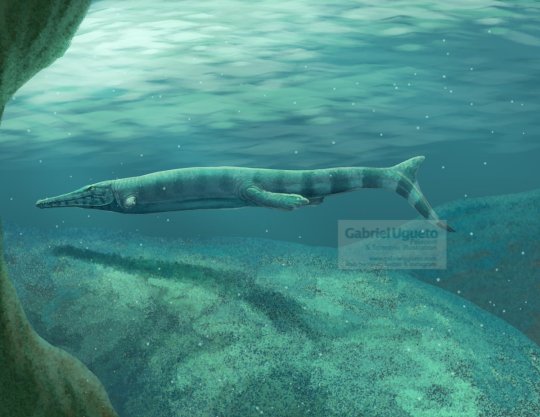
Thalattosuchians such as these two groups, which are sister clades and not successive lineages (so they co-occured rather than one having evolved from the other), were incredibly successful during the Jurassic, evolving enormous forms such as Plesiosuchus, Dakosaurus and Machimosaurus. Their wild success held on throughout the Jurassic until they eventually went extinct in the early Cretaceous. But despite how common and whidespread they are, we don't actually have much of a clue where they come from. Thalattosuchians just kinda appear during the Toarcian and are already found across multiple continents with both groups established. To complicate matters, their position among crocodiles is also rather shaky. Three main hypothesis exist. One is that they are a sister group to crocodyliforms (Protosuchians, Notosuchians and Neosuchians), that they are basal mesoeucrocodylians or that they are Neosuchians related to Pholidosaurids (like Sarcosuchus) and Dyrosaurs.
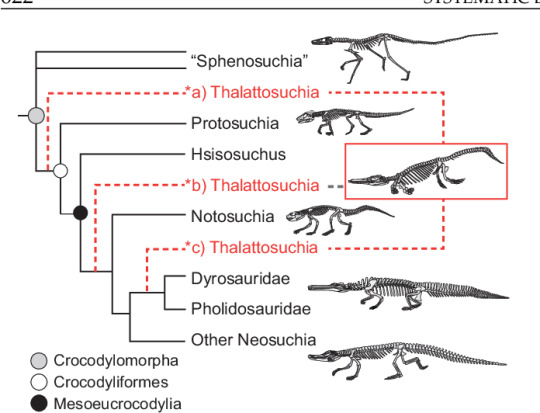
This is where Turnersuchus comes in. Discovered in the Charmouth Mudstone Formation of Dorset, England, this genus is known from the skeletal material belonging to the back of the head, mandible, parts of the forearms and shoulder girdle as well as neck, body and tail vertebrae all preserved in five blocks and a few isolated pieces of bone. From that we can already see general similarities to derived thalattosuchians and basic traits like narrow jaws and reduced forelimbs (tho not nearly as extreme as in metriorhynchids).
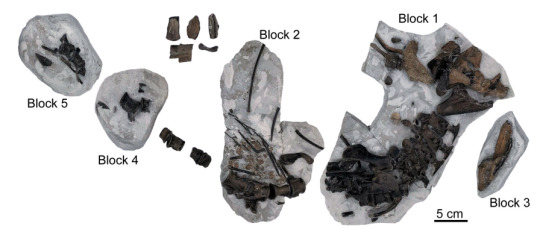
The first significant part about this discovery is its age. Turnersuchus is from the Pliensbachian stage of the Jurassic, so it predates any previously diagnostic thalattosuchians. Secondly is its position. As I said above, thalattosuchians are divided into teleosauroids and metriorhynchoids. But Turnersuchus is neither, with both phylogenetic analysis finding it to fall outside of these groups. Now in fairness this is not rock solid, as there is only a single trait excluding it from the derived groups in either analysis, so future works might shake things up. But as things are right now, it's the oldest named and basalmost member of the entire clade. On a sidenote at least the oldest part is bound to change, as the paper mentions a Moroccon teleosauroid currently in press that is even older.
All of this allows for two things. For one, by comparing Turnersuchus with the basal members of both teleosauroids and metriorhynchoids scientists were able to gather a list of traits that appear to be ancestral to the group. In addition, Turnersuchus also preserves some features that separate it from all other thalattosuchians that are also indicative of being an early member. Just as one example a specific part of the basioccipital thats associated with long skulls is poorly developed, which means that while slender the jaws weren't as long as in some later thalattosuchians. A Bayesian analysis was also conducted in an attempt to nail down when thalattosuchians evolved. Now depending on which phylogeny is used (one with thalattosuchians as non-crocodyliforms and another with them as mesoeucrocodylians) you get different times. The former would place their origin in the Norian stage of the Triassic, the later in the Sinemurian stage of the Jurassic. In light of the Moroccon material alluded to by the paper, it would appear that they likely split from other crocodylomorphs sometime in the late Triassic.
And finally to wrap this up let me share the press release artwork to finally give a face to all this information. Now if you've read my post about fossil crocs of 2022 you might already recognize the artist, as she's been on a real streak with illustrating fossil crocs. If you don't know her, I highly recommend checking out her work. I'm of course talking about Júlia d'Oliveira.

And yes, of course I got the Wikipedia page for it ready. Tho with work getting in the way when it was published I almost feared I'd be unable to get to it first.
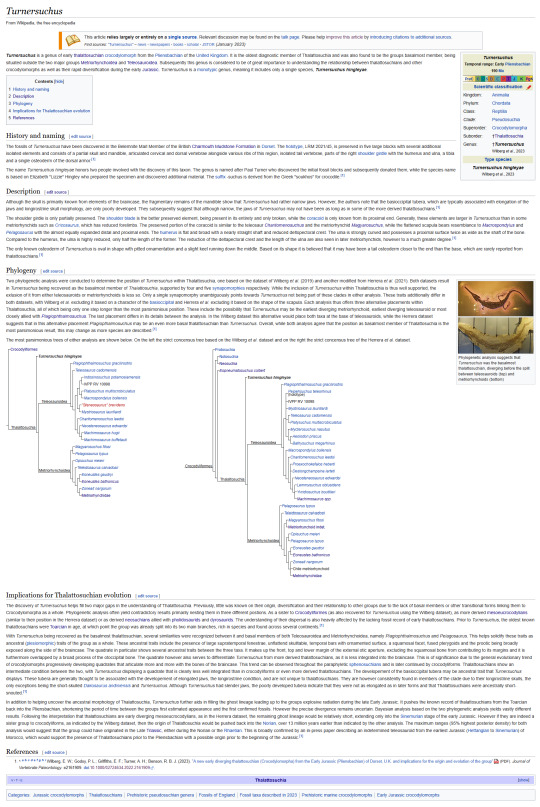
#turnersuchus#thalattosuchia#metriorhynchidae#teleosauridae#jurassic#paleontology#palaeblr#crocodylomorph#croc#pseudosuchian#marine reptile#long post#Wikipedia#paleontology news#crocodile
117 notes
·
View notes
Photo


Weather too hot to leave the house, means time for going back and revising some recent work. Here’s a toned painting that I put a little bit more into. A plesiosuchus for my final week of Animal Drawing at CGMA.
2 notes
·
View notes
Note
OK. I've been coming up with this idea for a Loooong time.
It's called Chronos, and it's an Isle-style MMO survival game where you can unlock new Dinosaurs with points. There are five kinds of points: Strike, Brute, Tank, Swift and Specialist. Each Dino can be unlocked for a different combination of 2-3 points, with 50 animals in total. You start with a few questions, which determines what points 3 you receive to start with- say you got Strike, Brute and Swift, you could buy Coelophysis, Stegoceras or Velociraptor to start off with.
Each animal has its own unique abilities and playstyle, like the Zephyrsaurus' burrowing, the Apatosaurus' tailwhip and the Tyrannosaurus' crushing bite. The roster will include famous Dinosaurs like Triceratops and Stegosaurus, but also lesser known genuses like Nemegtomaia, Anatosaurus, Masaikasaurus, Centrosaurus and Mapusaurus. Pterosaurs and Aquatics would be added later, again with obscure additions like Alcione and Plesiosuchus alongside the obvious Pteranodon and Mosasaurus.
A spinoff game could entail, a parkbuilder, with new Dinosaurs that might've been too dull or similar to others to play as, like Ouranosaurus, Thescelosaurus or Carcharodontosaurus.
If anyone here had the power to create the Ideal Dinosaur Video Game, what kind of game would you make and why?
13 notes
·
View notes
Text
Ancient marine crocs adapted like whales to ocean life - only earlier
https://sciencespies.com/news/ancient-marine-crocs-adapted-like-whales-to-ocean-life-only-earlier/
Ancient marine crocs adapted like whales to ocean life - only earlier
WASHINGTON (Reuters) – A wondrous lineage of crocodile relatives that developed into fast-swimming seagoing predators at a time when dinosaurs dominated the land adapted to life in the open ocean with a pivotal evolutionary modification also present in whales.
A life reconstruction of the Jurassic Period marine crocodile relative Cricosaurus is seen in this image released in Edinburgh, Scotland, Britain April 20, 2020. Dmitry Bogdanov/Handout via REUTERS
But the crocs did it more than 100 million years earlier.
Research published on Monday detailed changes in the inner ear’s vestibular system – responsible for the sense of balance and equilibrium – in the marine crocs called thalattosuchians, which appeared in the Jurassic Period about 182 million years ago and died out in the Cretaceous Period about 125 million years ago.
Like whales, thalattosuchians underwent major skeletal changes as they evolved from land-dwelling ancestors, turning limbs into flippers, streamlining their bodies and developing a fluked tail for strong swimming.
They also altered their sensory systems as evidenced by inner ear changes revealed in CAT scans of fossilized thalattosuchian skulls. Three looping semicircular canals in the inner ear became markedly fatter and smaller compared to those in their terrestrial kin.
Whales, which first appeared about 50 million years ago, possess similar inner ear anatomy that evolved independently of thalattosuchians.
“The changes in canal shape are better suited to life in the oceans, where buoyancy can hold up an animal, as compared to land, where animals need a highly sensitive sense of balance to cope with gravity and complex landscapes,” said Julia Schwab, a University of Edinburgh geosciences doctoral student and lead author of the study published in the journal Proceedings of the National Academy of Sciences.
The whale-thalattosuchian inner ear similarities are an example of a phenomenon called convergent evolution in which disparate organisms independently evolve similar features – like the wings of birds, bats and extinct flying reptiles called pterosaurs – to adapt to similar environments.
Thalattosuchians reached up to about 33 feet (10 meters) long. Some like fish-eating Teleosaurus and Machimosaurus remained semi-aquatic, still looking much like a crocodile. Others like Metriorhynchus and Plesiosuchus were fully adapted for the open ocean, hunting fish as well as squid cousins and even other marine reptiles.
They lived alongside other marine reptiles, some even bigger. Previous studies have shown some other marine reptile groups possessed similar inner ear adaptations.
“Thalattosuchians are one of the most peculiar groups of animals to ever live and it’s shocking to me that they don’t receive more attention,” University of Edinburgh paleontologist and study co-author Steve Brusatte said.
“What’s really neat is that we can tell thalattosuchians started changing their skeletons first – limbs into flippers, fluked tail, et cetera – which allowed them to move into the water and become better swimmers, and only later did their ears change, as their sensory systems had to evolve to keep up.”
Reporting by Will Dunham; Editing by Sandra Maler
Our Standards:The Thomson Reuters Trust Principles.
#News
0 notes
Photo

Plesiosuchus manselii, a 6.8 m long metriorhynchid crocodilian, swims through the ocean that covered parts of Europe in the Jurassic period.
More on my DeviantArt.
9 notes
·
View notes
Text
Two more croc-line archosaurs to dig into with this one and both are super fascinating.
Obviously the star of this piece is our friend in the foreground, Plesiosuchus manselii, the largest of the fully marine metriorhynchids (the skull of which being the first one shown in the image to the right, taken from Young et al. 2012)
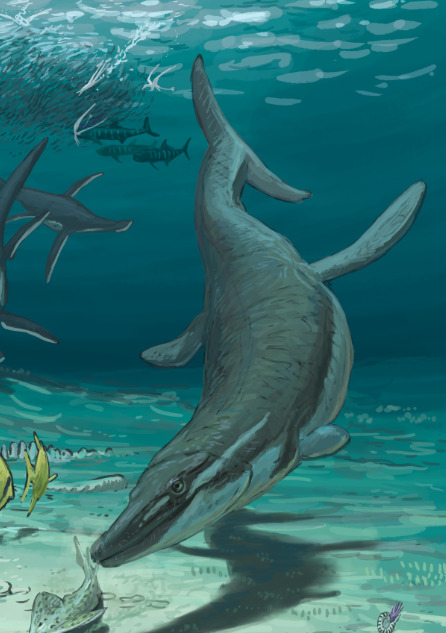
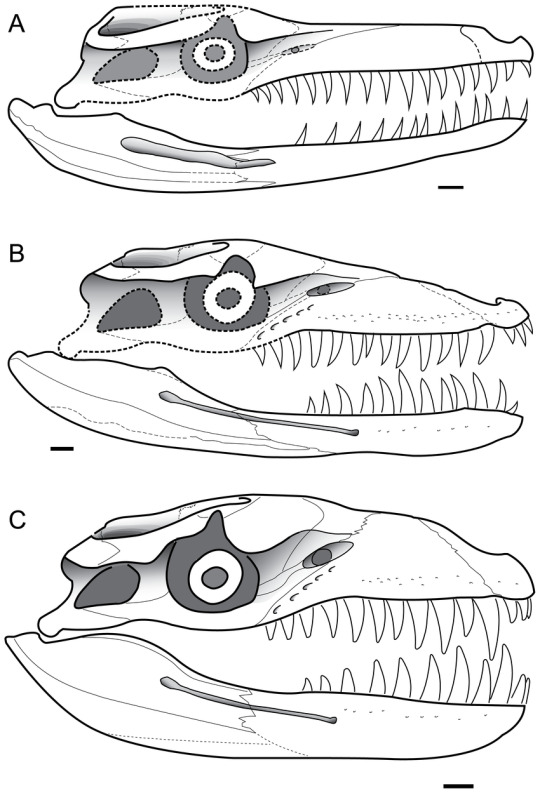
More broadly speaking, metriorhynchids are a fascinating group of early croc-relatives that stand out for having returned completely back into the water, developing a fluked tail, tiny little reduced forelimps, flipper like hindlimbs and smooth skin entirely lacking in the osteoderm armour we so strongly associate with pseudosuchians.
Plesiosuchus specifically is the largest of them. Close to 7 meters in length, it's basically in the same range as Liopleurodon (although smaller than several of the pliosaurs we know from the Kimmeridge Clay like that very decorative skeleton). Plesiosuchus actually wasn't the only metriorhynchid from the formation either. We also know of the small Cricosaurus, the name-giving Metriorhynchus and most interestingly the large-bodied Dakosaurus and Torvoneustes, which were likely to reach lengths of 4.5 to 4.7 meters respectively. At least with metriorhynchids this diversity can be explained in the different animals having very different preferences. Torvoneustes is interpreted as a durophage, feeding on hard-shelled prey. Dakosaurus is characterized by slicing dentition, potentially able to cut apart large prey with tooth wear possibly suggesting sharks or suction feeding habits. Plesiosaurus meanwhile would be able to take on large prey simply due to its great size and large gape but may have been limited by the size of its own head.
The other marine "croc" in the image is Bathysuchus, which may be described as a cousin to the metriorhynchids.
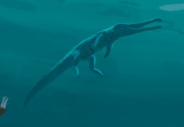
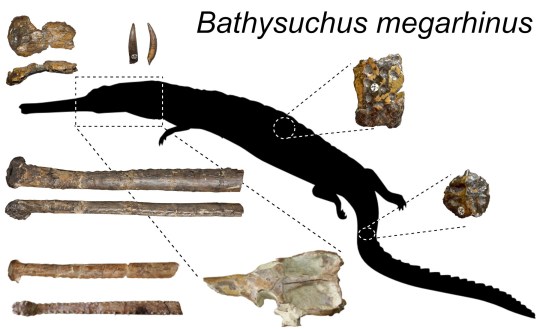
Remember Machimosaurus from the Guimarota locality that Josch drew a few weeks back? Yeah its related to that one. A teleosauroid to be precise, which are the sister group to metriorhynchoids and appear much more croc-like in their appearance despite still being a long way off from crocodiles in the strict sense. Teleosauroids may appear like what you'd think of as basal to metriorhynchoids, but they simply did their own thing after diverging, thus retaining this more ancestral bauplan with more developed limbs, more croc-like skulls and maintaining their armour plating (keep that in mind).
Bathysuchus is kind of a weird one tho. Why? Because from what we can tell Bathysuchus seems to have tried to become more like its metriorhynchoid cousins. It's known from deeper waters, its osteoderms were much more reduced and if the closely related Aelodon is anything to go from then its quite likely that this guy also started reducing the size of its forelimbs. In short, adaptations to a more pelagic lifestyle that moves away from the coastal habitat other teleosauroids seem to have preferred. Who knows, maybe its possible that in some other timeline these guys might have become something akin to metriorhynchoids like what happened with mosasaurs.
Unlike metriorhynchoids, teleosauroids were way less common in the Kimmeridge Clay, hell, to my knowledge Bathysuchus is the only one of them, a pretender among the other pelagic pseudosuchians.


Result from the Kimmeridge Clay #paleostream!
We were only able to scratch the surface, but I think you get the idea ;)
#bathysuchus#plesiosuchus#kimmeridge clay#crocs#pseudosuchia#crocodile#metriorhynchidae#metriorhynchoidea#teleosauroidea#thalattosuchia#crocodyliform#jurassic#marine croc#paleostream#palaeoblr
598 notes
·
View notes
Text
THALATTOSUCHIANS SIGHTED!!!!


Result from the Kimmeridge Clay #paleostream!
We were only able to scratch the surface, but I think you get the idea ;)
598 notes
·
View notes